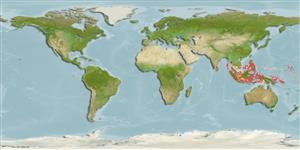>
Gobiiformes (Gobies) >
Gobiidae (Gobies) > Gobiinae
Etymology: Amblyeleotris: Greek, amblys = darkness + The name of a Nile fish, eleotris (Ref. 45335).
Eponymy: Surgeon Major H R F Fontanes was a Dutch East Indian Army physician in Macassar, Celebes. He provided a collection of fishes from Bulucumba, Sulawesi, Indonesia, presumably including the type of the goby. (Ref. 128868), visit book page.
More on author: Bleeker.
Environment: milieu / climate zone / depth range / distribution range
Ecología
marino; salobre asociado a arrecife; rango de profundidad 5 - 30 m (Ref. 90102). Tropical; 19°N - 9°S
Distribución
Países | Áreas FAO | Ecosistemas | Ocurrencias, apariciones | Point map | Introducciones | Faunafri
Western Pacific: Sumatra to the Moluccas, north to the Philippines; Palau in Micronesia. Reported from Papua New Guinea (Ref. 6771) and south of Taiwan (Ref. 5193).
Tamaño / Peso / Age
Maturity: Lm ? range ? - ? cm
Max length : 25.0 cm SL macho / no sexado; (Ref. 48637)
Short description
Claves de identificación | Morfología | Morfometría
Espinas dorsales (total) : 7; Radios blandos dorsales (total) : 15; Espinas anales: 1; Radios blandos anales: 16 - 17. Characterized by whitish body color; head and body with five brown bars; small orange spots on head; first dorsal fin with large dark blotch; pelvic fins fully united with well developed frenum; predorsal scales extending forward to less than orbit diameter from interorbital space; longitudinal scale series 110; greatest depth of body 5.8-6.3 in SL; pointed caudal fin, longer than head (Ref. 90102).
Inhabits silty inshore bottoms, deep coastal mud slopes and also occurs in estuaries in muddy channels (Ref. 48637). Also found in sand bottoms of lagoons and sheltered reefs in 5-30 m (Ref. 90102).
Life cycle and mating behavior
Madurez | Reproducción | Puesta | Huevos | Fecundidad | Larva
Myers, R.F., 1991. Micronesian reef fishes. Second Ed. Coral Graphics, Barrigada, Guam. 298 p. (Ref. 1602)
IUCN Red List Status (Ref. 130435: Version 2024-1)
Threat to humans
Harmless
Human uses
Pesquerías: comercial; Acuario: Comercial
Herramientas
Special reports
Download XML
Fuentes de Internet
Estimates based on models
Preferred temperature (Ref.
123201): 28.4 - 29.3, mean 28.8 °C (based on 1002 cells).
Phylogenetic diversity index (Ref.
82804): PD
50 = 0.5000 [Uniqueness, from 0.5 = low to 2.0 = high].
Bayesian length-weight: a=0.00724 (0.00339 - 0.01546), b=3.10 (2.92 - 3.28), in cm total length, based on LWR estimates for this (Sub)family-body shape (Ref.
93245).
Nivel trófico (Ref.
69278): 3.5 ±0.4 se; based on size and trophs of closest relatives
Resiliencia (Ref.
120179): Medio, población duplicada en un tiempo mínimo de 1.4-4.4 años (Preliminary K or Fecundity.).
Fishing Vulnerability (Ref.
59153): Low vulnerability (21 of 100).
